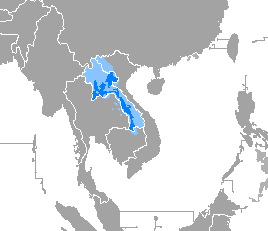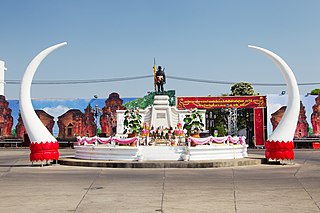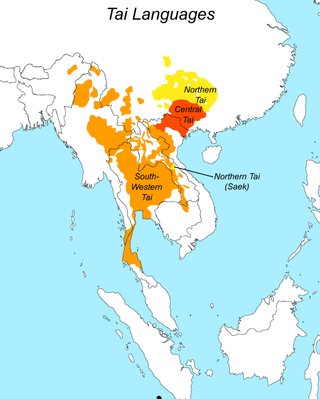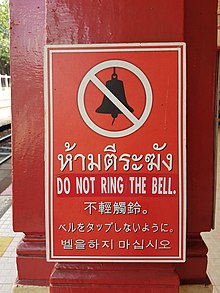
Demographic features of the population of Cambodia include population density, ethnicity, education level, health of the populace, economic status, religious affiliations and other aspects of the population.

The demographics of Thailand paint a statistical portrait of the national population. Demography includes such measures as population density and distribution, ethnicity, educational levels, public health metrics, fertility, economic status, religious affiliation, and other characteristics of the populace.

Lao, sometimes referred to as Laotian, is the official language of Laos and a significant language in the Isan region of northeastern Thailand, where it is usually referred to as the Isan language. Spoken by over 3 million people in Laos and 3.2 million in all countries, it serves as a vital link in the cultural and social fabric of these areas. It is written in the Lao script, an abugida that evolved from ancient Tai scripts.

The Lao people are a Tai ethnic group native to Southeast Asia, who speak the Lao language of the Kra–Dai languages. They are the majority ethnic group of Laos, making up 53.2% of the total population. The majority of Lao people adhere to Theravada Buddhism. They are closely related to other Tai people, especially with the Isan people, who are also speakers of Lao language, native to neighboring Thailand.

Northeast Thailand or Isan consists of 20 provinces in northeastern Thailand. Isan is Thailand's largest region, on the Khorat Plateau, bordered by the Mekong River to the north and east, by Cambodia to the southeast and the Sankamphaeng Range south of Nakhon Ratchasima. To the west it is separated from northern and central Thailand by the Phetchabun Mountains. Isan covers 167,718 km2 (64,756 sq mi), making it about half the size of Germany and roughly the size of England and Wales. The total forest area is 25,203 km2 (9,731 sq mi) or 15 percent of Isan's area.

Surin is one of Thailand's seventy-seven provinces (changwat). It lies in lower northeastern Thailand, also called Isan. Neighboring provinces are Buriram, Maha Sarakham, Roi Et, and Sisaket. To the south it borders Oddar Meancheay of Cambodia. Surin covers a total area of 8,124 km2 (3,137 sq mi) from the Mun River in the north to the Dangrek Mountains in the south. The capital, Surin city, in the western central region province is 434 km from Bangkok.

Isan or Northeastern Thai refers to the local development of the Lao language in Thailand, after the political split of the Lao-speaking world at the Mekong River at the conclusion of the Franco-Siamese crisis of 1893. The language is still referred to as Lao by native speakers.
Southern Thai, also known as Dambro, Pak Tai, or "Southern language", is a Southwestern Tai ethnolinguistic identity and language spoken in southern Thailand as well as by small communities in the northernmost Malaysian states. It is spoken by roughly five million people, and as a second language by the 1.5 million speakers of Pattani and other ethnic groups such as the local Peranakans communities, Negritos, and other tribal groups. Most speakers are also fluent in or understand the Central Thai dialects.
Tai Dam, also known as Black Tai, is a Tai language spoken by the Tai Dam in Vietnam, Laos, Thailand, and China.

Thai people, Chao Phraya Thai, Central Thai people, Southern Thai people, Siamese, Thai Siam, Tai Noi people, are a Southeast Asian ethnic group native to Thailand. In a narrower sense, the Thais are also a Tai ethnic group dominant in Central and Southern Thailand. Part of the larger Tai ethno-linguistic group native to Southeast Asia as well as Southern China and Northeast India, Thais speak the Sukhothai languages, which is classified as part of the Kra–Dai family of languages. The majority of Thais are followers of Theravada Buddhism.

The largest of the ethnic groups in Cambodia are the Khmer, who comprise 95.8% of the total population and primarily inhabit the lowland Mekong subregion and the central plains. The Khmer historically have lived near the lower Mekong River in a contiguous arc that runs from the southern Khorat Plateau where modern-day Thailand, Laos and Cambodia meet in the northeast, stretching southwest through the lands surrounding Tonle Sap lake to the Cardamom Mountains, then continues back southeast to the mouth of the Mekong River in southeastern Vietnam.
Northern Khmer, also called Surin Khmer, is the dialect of the Khmer language spoken by approximately 1.4 million Khmers native to the Thai provinces of Surin, Sisaket, Buriram and Roi Et as well as those that have migrated from this region into Cambodia.

Thailand is a country of some 70 ethnic groups, including at least 24 groups of ethnolinguistically Tai peoples, mainly the Central, Southern, Northeastern, and Northern Thais; 22 groups of Austroasiatic peoples, with substantial populations of Northern Khmer and Kuy; 11 groups speaking Sino-Tibetan languages, with the largest in population being the Karen; 3 groups of Austronesian peoples, i.e., the Malay, the majority ethnic group in the southernmost three provinces, together with the Moken and Urak Lawoi ; and both groups of Hmong-Mien. Other ethnic groups include longstanding immigrant communities such as the Chinese, Indians and Thai Portuguese.
Phuan or Northeastern Lao is a Tai language spoken in Laos, Thailand and Cambodia.
The Rau people, also known as Lao, were an ethnic group of ancient China. Their descendants are the Zhuang, Buyei, Tay–Nùng and other Kra–Dai-speaking peoples.

The Isan people or literally Northeastern people are an ethnic group native to Northeastern Thailand with an estimated population of about 22 million. Alternative terms for this group are T(h)ai Isan, Thai-Lao, Lao Isan, or Isan Lao. Like Central Thai (Siamese) and Lao, they belong to the linguistic family of Tai peoples.

Tai peoples are the populations who speak the Tai languages. There are a total of about 93 million people of Tai ancestry worldwide, with the largest ethnic groups being Dai, Thais, Isan, Tai Yai (Shan),Tai Lai (Shanni), Lao, Tai Ahom, Tai Meitei and Northern Thai peoples.

The Kuy are an indigenous ethnic group of mainland Southeast Asia. The native lands of the Kuy range from the southern Khorat Plateau in northeast Thailand east to the banks of the Mekong River in southern Laos and south to north central Cambodia. The Kuy are an ethnic minority in all three countries, where they live as "hill tribes" or Montagnards. Their language is classified as a Katuic language of the Mon-Khmer language family. The Thais, Lao, and Khmer traditionally recognize the Kuy as the aboriginal inhabitants of the region. The word kuy in the Kuy language means "people" or "human being"; alternate English spellings include Kui, Kuoy and Kuay, while forms similar to "Suay" or "Suei" are derived from the Thai/Lao exonyms meaning "those who pay tribute". The Kuy are known as skilled mahouts, or elephant trainers, and many Kuy villages are employed in finding, taming, and selling elephants.

The Nyah Kur are an ethnic group native to Thailand in Southeast Asia. Closely related to the Mon people, the Nyah Kur are the descendants of the Mon of Dvaravati who did not flee westward or assimilate when their empire fell under the influence of the Khmer when Suryavarman I gained the throne in the early 11th century.

Lao and Thai are two closely related languages of the Southwestern branch of Tai languages. Lao falls within the Lao-Phuthai group of Southwestern Tai languages and Thai within the Chiang Saen language group. Lao and Thai, although they occupy separate groups, are mutually intelligible and were pushed closer through contact and Khmer influence, but all Southwestern Tai languages are mutually intelligible to some degree. Isan refers to the local development of the Lao language in Thailand, as it diverged in isolation from Laos, under Thai influence. The Isan language is still referred to as Lao by native speakers. Spoken Lao is mutually intelligible with Thai and Isan to such a degree that their speakers are able to effectively communicate with one another speaking their respective languages. These languages are written with slightly different scripts, the Lao script and Thai script, but are linguistically similar and effectively form a dialect continuum.















